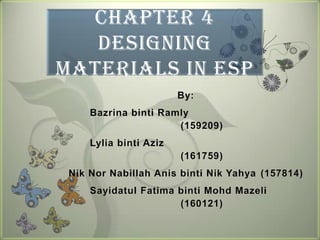
Esp chap 4 materials design (finished)
- 1. Chapter 4 Designing Materials in ESP By: Bazrina binti Ramly (159209) Lylia binti Aziz (161759) Nik Nor Nabillah Anis binti Nik Yahya (157814) Sayidatul Fatima binti Mohd Mazeli (160121)
- 2. Definition Forms of Materials Roles of Materials Characteristics of Materials Where to get Materials Sample of Materials Conclusion Questions
- 3. Materials can be anything in linguistic, visual, auditory and kinaesthetic forms that are used to facilitate the teaching and learning process. (Tomlinsom,1998)
- 4. a) linguistic b) auditory c) visual d) kinaesthetic
- 5. According to Harsono (2007), materials can also be: a) experiential b) elicitative c) instructional d) exploratory
- 6. Consider: 1. needs and wants of the learners 2. language choice 3. development of specific skills 4. Strategies for operating in ESP context
- 7. Stimulation and motivation Source of language Learning support For reference and enrichment Revision
- 8. Teacher-generated Materials Learner-generated Materials Authentic Materials
- 9. Materials specifically generated for teachers that teach ESP. Factors that need to be taken into account: • Matching carrier content to real content • Providing variety • Grading exercises • Presenting the material well
- 10. Real content - the main purpose of the course Carrier content - aspects that is used to assist the real content (e.g.: English for Banking)
- 12. Variety in micro-skills - Focus on more than one macro-skill (e.g writing, speaking, reading, listening) Variety in types of activities - Using visuals & thinking based activities (e.g diagrams, flowcharts) Variety in interaction - Changes from teacher input to individual work to pair work to class discussion
- 13. Grading basically helps provide learners with tasks at different levels of difficulty. One way to achieve this is by setting tasks in three levels. (e.g unsupported, partially supported, fully supported)
- 15. Materials specifically generated by learners for their own learning experience. Examples: Framework materials Activities that are devised by learners
- 16. Remove the difficulty to balance the levels and appropriateness of carrier and real content Set a context or a framework learners fit their own carrier content and their existing language competence
- 17. Relocation of head office to a new site London Midlands Prestigious Space to expand Close to Heathrow Airport Some loss of personnel Traffic Congestion More flexible layout More expensive Good road and air communication Short-term relocation costs Production Process Advantages Disadvantages
- 18. Text comprehension - A pair of learners prepare some comprehension questions (as well as the answers) and exchange them with another pair. Each pair will answer the other pair's set of questions. Note taking / Information transfer - Learners themselves can think of some creative activities to transfer information for their peers (and their teachers) Vocabulary Development - Learners can generate their own sets or word partnerships
- 19. Carefully selected so that it’ll be appropriate to the subject Make sure do not go out of the intended topic Teacher knows the level of the students’ language knowledge and the target level they want to achieve (course objectives) Select or design materials/task that will simulate the students’ real-life situation as closely as possible Leave room for flexibility
- 20. Teachers should consider the following questions in selecting the materials (Lewis & Hill,1993) : Will the materials be useful to the students? Do they stimulate students’ curiosity? Are the materials relevant to the students and their needs? Are they fun to do? Will the students find the tasks and activities worth doing?
- 21. I) Textbook-based Readily available Psychologically represents something concrete Publishers, commercial companies Bookstores, conferences, colleagues, friends, web pages Teachers will know what materials are available and what materials are appropriate for various purposes Be creative
- 22. II) Tailor-made More precisely geared to the needs of the students Collecting the materials when the teachers go abroad to English speaking country Browsing the internet for ideas TVs and radios (current information) Printed materials Provide the teachers with the opportunity to decide on the vocabulary, functions and structures combination that will be most relevant
- 23. Teachers can rely on some important considerations (Haycraft, 1987): length of the course. The target audience of the course. The appropriate structural grading: students should be taught what they need to know “in the right order with the right priorities”. The vocabulary should be useful and in current use. The appropriate idiomatic English. The materials should be “visually alive” and “well presented”.
- 24. Refer to PDF documents.
- 25. Definition of materials Forms of materials The role of materials Categories of materials Materials Selection Sources of materials Sample of materials
- 26. Materials are not just a mere tools that can be randomly use to assist the teaching and learning process, but, materials are also one of the important aspects in teaching ESP to guide the teachers and students in understanding the subjects better.
- 27. Briefly define the meaning of materials. Briefly explain two roles of materials for ESP teaching and learning. What are the three categories of the materials? How does a teacher get ideas for tailor-made materials? Explain. Give one benefit each for textbook and tailor-made materials.
